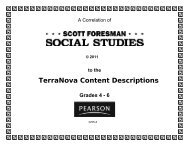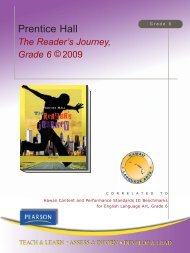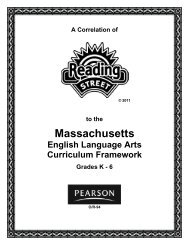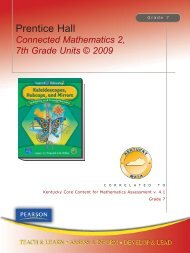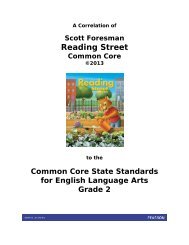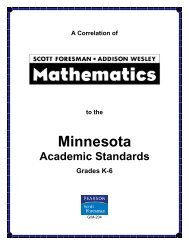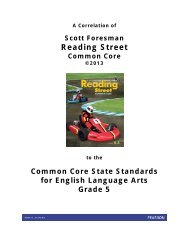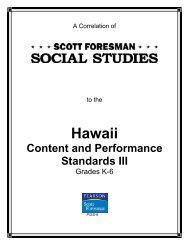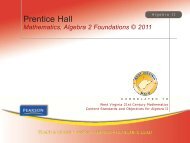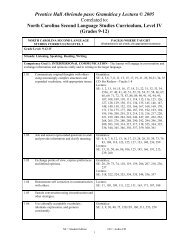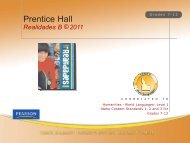Connected Mathematics 2, Grade 6 Units - Pearson
Connected Mathematics 2, Grade 6 Units - Pearson
Connected Mathematics 2, Grade 6 Units - Pearson
- No tags were found...
You also want an ePaper? Increase the reach of your titles
YUMPU automatically turns print PDFs into web optimized ePapers that Google loves.
Textbook Alignment to the Utah Core – 6 th <strong>Grade</strong> <strong>Mathematics</strong>This alignment has been completed using an “Independent Alignment Vendor” from the USOE approved list(www.schools.utah.gov/curr/imc/indvendor.html.) Yes N/A No N/AName of Company and Individual Conducting Alignment:McHugh and Associates, Inc.A “Credential Sheet” has been completed on the above company/evaluator and is (Please check one of the following):□ On record with the USOE.x The “Credential Sheet” is attached to this alignment.Instructional Materials Evaluation Criteria (name and grade of the core document used to align): 6 th <strong>Grade</strong> <strong>Mathematics</strong> CoreCurriculumTitle: <strong>Connected</strong> <strong>Mathematics</strong> 2, 6th <strong>Grade</strong> <strong>Units</strong> (c) 2009 ISBN#:SE: Prime Time: 0-13-366104-0, Bits and Pieces I: 0-13-366130-X, Shapes and Designs: 0-13-366131-8, Bits and Pieces II: 0-13-366132-6, Covering and Surrounding: 0-133-366133-4, Bits and Pieces III: 0-13-366134-2, How Likely Is It?: 0-13-366135-0, Data About Us: 0-13-366136-9, Single Bind:0-13-366107-5 (SE, Single Bind); TE: Prime Time: 0-13-366108-3, Bits and Pieces I: 0-13-366184-9, Shapes andDesigns: 0-13-366187-3, Bits and Pieces II: 0-13-366185-7, Covering and Surrounding: 0-13-366189-X, Bits and Pieces III: 0-13-366186-5,How Likely Is It?: 0-13-366190-3, Data About Us: 0-13-366191-1, Teacher’s Guide Package: 0-13-165883-2 (Teacher's Guide Package);Publisher: <strong>Pearson</strong> Education, Inc. publishing as Prentice HallOverall percentage of coverage in the Student Edition (SE) and Teacher Edition (TE) of the Utah State Core Curriculum: 52%
a. Place rational numbers on the number line. SE: Bits and Pieces I Investigation1: Fundraising Fractions (14, 17),Investigation 2: Sharing andComparing With Fractions (21-23,25-27, 30, 32-33), Investigation 3:Moving Between Fractions andDecimals (48, 52), Investigation 4:Working With Percents (66), Bitsand Pieces II Investigation 1:Estimating With Fractions (12),Investigation 4: Dividing WithFractions (59), Bits and Pieces IIIInvestigation 3: The Decimal Divide(45, 47)TE: Bits and Pieces I Investigation1: Fundraising Fractions (41-42),Investigation 2: Sharing andComparing With Fractions (51-56,67-72, 74-76), Investigation 3:Moving Between Fractions andDecimals (108, 110), Investigation4: Working With Percents (134),Bits and Pieces II Investigation 1:Estimating With Fractions (32),Investigation 4: Dividing WithFractions (117), Bits and Pieces IIIInvestigation 3: The Decimal Divide(81)b. Compare and order rational numbers, including positiveand negative mixed fractions and decimals, using avariety of methods and symbols, including the numberSE: Bits and Pieces I Investigation1: Fundraising Fractions (10-11),Investigation 2: Sharing and
line and finding common denominators. Comparing With Fractions (19-24,28-29, 33-34), Investigation 3:Moving Between Fractions andDecimals (35-39, 41-43, 45-46, 49-50, 53), Investigation 4: WorkingWith Percents (65), Shapes andDesigns Investigation 1: Bees andPolygons (20), Bits and Pieces IIInvestigation 1: Estimating WithFractions (13), Investigation 2:Adding and Subtracting Fractions(28), Covering and SurroundingInvestigation 4: MeasuringParallelograms (65), Bits andPieces III Investigation 1:Decimals-More or Less! (16), HowLikely Is It? Investigation 2:Experimental and TheoreticalProbability (33), Investigation 3:Making Decisions With Probability(49)TE: Bits and Pieces I Investigation1: Fundraising Fractions (35-40),Investigation 2: Sharing andComparing With Fractions (46-66,73-74, 76), Investigation 3: MovingBetween Fractions and Decimals(79-84, 91-96, 101-106, 109),Investigation 4: Working WithPercents (134), Shapes and DesignsInvestigation 1: Bees and Polygons
c. Find equivalent forms for common fractions, decimals,percents, and ratios, including repeating or terminatingdecimals.(33), Bits and Pieces IIInvestigation 1: Estimating WithFractions (32), Investigation 2:Adding and Subtracting Fractions(56), Covering and SurroundingInvestigation 4: MeasuringParallelograms (107), Bits andPieces III Investigation 1:Decimals-More or Less! (34), HowLikely Is It? Investigation 2:Experimental and TheoreticalProbability (56), Investigation 3:Making Decisions With Probability(73)SE: Bits and Pieces I Investigation1: Fundraising Fractions (7, 10-12,15), Investigation 2: Sharing andComparing With Fractions (19-28,31), Investigation 3: MovingBetween Fractions and Decimals(35-44, 47-51), Investigation 4:Working With Percents (58-60, 62-66), Shapes and DesignsInvestigation 1: Bees and Polygons(20), Investigation 2: Polygons andAngles (47), Bits and Pieces IIInvestigation 1: Estimating WithFractions (5-7, 10, 12-14),Investigation 2: Adding andSubtracting Fractions (26-27),Investigation 4: Dividing With
composite, or neither. Factors and Products (9-11, 15-16,19, 21), Investigation 2: Whole-Number Patterns and Relationships(22-24, 26-29, 33-34), Investigation4: Factorizations: Searching forFactor Strings (57-58), Investigation5: Putting It All Together (61-64,66-67)TE: Prime Time Investigation 1:Factors and Products (21-24, 31-34),Investigation 2: Whole-NumberPatterns and Relationships (36-40,45-48, 51), Investigation 4:Factorizations: Searching for FactorStrings (93-94), Investigation 5:Putting It All Together (96-102)b. Find the prime factorization of composite numbers to100.c. Find the greatest common factor and least commonmultiple for two numbers using a variety of methods(e.g., list of multiples, prime factorization).SE: Prime Time Investigation 4:Factorizations: Searching for FactorStrings (50-52, 53-58, 60),Investigation 5: Putting It AllTogether (61-64, 66-67)TE: Prime Time Investigation 4:Factorizations: Searching for FactorStrings (81-94), Investigation 5:Putting It All Together (96-102)SE: Prime Time Investigation 2:Whole-Number Patterns andRelationships (26-29, 32),Investigation 3: Common Multiplesand Common Factors (37-48),Investigation 4: Factorizations:
. Recognize that ratios derive from pairs of rows in themultiplication table and connect with equivalentfractions.c. Give mixed number and decimal solutions to divisionproblems with whole numbers.Objective 1.5: Solve problems involving multiple steps.a. Select appropriate methods to solve a multi-stepproblem involving multiplication and division offractions and decimals.b. Use estimation to determine whether results obtainedusing a calculator are reasonable.c. Use estimation or calculation to compute results,depending on the context and numbers involved in theproblem.88), Investigation 4: Dividing WithFractions (92-114, 118)SE: Bits and Pieces II Investigation3: Multiplying With Fractions (42-45), Investigation 4: Dividing WithFractions (61), Bits and Pieces IIIInvestigation 2: Decimal Times (28-29, 32-34), Investigation 3: TheDecimal Divide (46-47)TE: Bits and Pieces IIInvestigation 3: Multiplying WithFractions (86-87), Investigation 4:Dividing With Fractions (118),Bitsand Pieces III Investigation 2:Decimal Times (57, 59),Investigation 3: The Decimal Divide(81)SE: Bits and Pieces II Investigation1: Estimating With Fractions (5-11,15), Investigation 3: MultiplyingOnline Activity: AL-hUsing Proportions andProportional ReasoningThis standard can bedeveloped from:Online Activity: NO-lMultiplying and DividingRational Numbers
With Fractions (32-37, 41), Bitsand Pieces III Investigation 1:Decimals-More or Less! (5-7, 10-11, 13-14, 20), Investigation 2:Decimal Times (21-25, 28-30, 35),Investigation 3: The Decimal Divide(36-39)TE: Bits and Pieces IIInvestigation 1: Estimating WithFractions (20-33), Investigation 3:Multiplying With Fractions (60-74,86), Bits and Pieces IIIInvestigation 1: Decimals-More orLess! (16-20, 25-28, 33, 35),Investigation 2: Decimal Times (37-42, 47-50, 57-59), Investigation 3:The Decimal Divide (62-70)d. Solve problems involving ratios and proportions. Online Activities: AL-hUsing Proportions andProportional Reasoning,AL-q ProportionalRelationshipsObjective 1.6: Demonstrate proficiency with the fouroperations, with positive rational numbers, and with additionand subtraction of integers.a. Multiply and divide a multi-digit number by a two-digitnumber, including decimals.SE: Bits and Pieces II Investigation2: Decimal Times (21-35),Investigation 3: The Decimal Divide(36-49)TE: Bits and Pieces II
forPercentage of coverage in the student and teacher editionStandard II: 0 %Percentage of coverage not in student or teacher edition, butcovered inthe ancillary material for Standard II: 83 %OBJECTIVES & INDICATORSObjective 2.1: Analyze algebraic expressions, tables, and graphsto determine patterns, relations, and rules.Coverage in Student Edition(SE)andTeacher Edition (TE) (pg #’s,etc.)Coverage inAncillary Material(titles, pg #’s, etc.)Not coveredin TE, SE orancillariesa. Describe simple relationships by creating and analyzingtables, equations, and expressions.b. Draw a graph and write an equation from a table ofvalues.c. Draw a graph and create a table of values from anequation.Objective 2.2: Write, interpret, and use mathematicalexpressions, equations, and formulas to represent and solveproblems that correspond to given situations.Online Activities: AL-iDescribing and Graphingy=kx Relationships andUsing ProportionalReasoning, GM-aPythagorean TheoremOnline Activities: AL-iDescribing and Graphingy=kx Relationships andUsing ProportionalReasoning, AL-l Sequences,AL-m Modeling Data Witha Linear FunctionOnline Activity: AL-jInverse ProportionalRelationships
a. Solve single variable linear equations using a variety ofstrategies.b. Recognize that expressions in different forms can beequivalent and rewrite an expression to represent aquantity in a different way.c. Evaluate and simplify expressions and formulas,substituting given values for the variables (e.g., 2x + 4;x = 2; therefore, 2 (2) + 4 = 8).Online Activities: AL-bProperties of Equality, AL-fSolving Multi-StepEquations, AL-o SolvingOne-Step EquationsOnline Activities: AL-gEvaluating AlgebraicExpressions, GM-aPythagorean Theorem, GMnSurface Area, GM-sCircles, GM-t InvestigatingVolume, GM-u Formulasfor TrapezoidsSTANDARD III: Students will use spatial and logical reasoning to recognize, describe, and analyze geometric shapes and principles.forPercentage of coverage in the student and teacher editionStandard III: 33 %Percentage of coverage not in student or teacher edition, butcovered inthe ancillary material for Standard III: 64 %OBJECTIVES & INDICATORSObjective 3.1: Identify and analyze attributes and properties ofgeometric shapes to solve problems.Coverage in Student Edition(SE)andTeacher Edition (TE) (pg #’s,etc.)Coverage inAncillary Material(titles, pg #’s, etc.)Not coveredin TE, SE orancillaries
a. Identify the midpoint of a line segment and the centerand circumference of a circle.b. Identify angles as vertical, adjacent, complementary, orsupplementary and provide descriptions of these terms.c. Develop and use the properties of complementary andsupplementary angles and the sum of the angles of atriangle to solve problems involving an unknown anglein a triangle or quadrilateral.Objective 3.2: Visualize and identify geometric shapes afterapplying transformations on a coordinate plane.a. Rotate a polygon about the origin by a multiple of 90°and identify the location of the new vertices.b. Translate a polygon either horizontally or vertically on acoordinate grid and identify the location of the newvertices.SE: Shapes and DesignsInvestigation 2: Polygons andAngles (50-51)TE: Shapes and DesignsInvestigation 2: Polygons andAngles (60)SE: Shapes and DesignsInvestigation 3: Polygon Propertiesand Tiling (54-57, 60-67, 69),Investigation 4: Building Polygons(79-80), Bits and Pieces IIIInvestigation 1: Decimals-More orLess! (17)TE: Shapes and DesignsInvestigation 3: Polygon Propertiesand Tiling (63-70, 75-81),Investigation 4: Building Polygons(96), Bits and Pieces IIIInvestigation 1: Decimals-More orLess! (34)Online Activity: GM-nSpecial AnglesOnline Activity: GM-mRotations in the CoordinatePlaneOnline Activity: GM-kTranslations in theCoordinate Plane
c. Reflect a polygon across either the x- or y-axis andOnline Activity: GM-lidentify the location of the new vertices.Reflections in theCoordinate PlaneSTANDARD IV: Students will understand and apply measurement tools and techniques and find the circumference and area of a circle.forPercentage of coverage in the student and teacher editionStandard IV: 60 %Percentage of coverage not in student or teacher edition, butcovered inthe ancillary material for Standard IV: 40 %OBJECTIVES & INDICATORSObjective 4.1: Describe and find the circumference and area ofa circle.a. Explore the relationship between the radius anddiameter of a circle to the circle’s circumference todevelop the formula for circumference.Coverage in Student Edition(SE)andTeacher Edition (TE) (pg #’s,etc.)SE: Covering and SurroundingInvestigation 5: Measuring IrregularShapes and Circles (72-76, 80-81,88)TE: Covering and SurroundingInvestigation 5: Measuring IrregularShapes and Circles (115-122, 129-130, 132)b. Find the circumference of a circle using a formula. SE: Covering and SurroundingInvestigation 5: Measuring IrregularShapes and Circles (80-83, 86-87)TE: Covering and SurroundingInvestigation 5: Measuring IrregularShapes and Circles (129-131)c. Describe pi as the ratio of the circumference to the SE: Covering and SurroundingCoverage inAncillary Material(titles, pg #’s, etc.)Not coveredin TE, SE orancillaries
diameter of a circle.d. Decompose a circle into a number of wedges andrearrange the wedges into a shape that approximates aparallelogram to develop the formula for the area of acircle.Investigation 5: Measuring IrregularShapes and Circles (77)TE: Covering and SurroundingInvestigation 5: Measuring IrregularShapes and Circles (123-128)SE: Covering and SurroundingInvestigation 5: Measuring IrregularShapes and Circles (77)TE: Covering and SurroundingInvestigation 5: Measuring IrregularShapes and Circles (123-128)e. Find the area of a circle using a formula. SE: Covering and SurroundingInvestigation 5: Measuring IrregularShapes and Circles (77, 81-83, 85),Bits and Pieces III Investigation 2:Decimal Times (32), Investigation3: The Decimal Divide (47)TE: Covering and SurroundingInvestigation 5: Measuring IrregularShapes and Circles (123-128, 130-131), Bits and Pieces IIIInvestigation 2: Decimal Times(59), Investigation 3: The DecimalDivide (81)Objective 4.2: Identify and describe measurable attributes ofobjects and units of measurement, and solve problems involvingmeasurement.a. Recognize that measurements are approximations and Online Activities: ME-a
describe how the size of the unit used in measuringaffects the precision.b. Convert units of measurement within the metric systemand convert units of measurement within the customarysystem.c. Compare a meter to a yard, a liter to a quart, and akilometer to a mile.d. Determine when it is appropriate to estimate or useprecise measurement when solving problems.SE: Shapes and DesignsInvestigation 2: Polygons andAngles (32-37, 42, 44-45)TE: Shapes and DesignsInvestigation 2: Polygons andAngles (45-52, 58)Using Fractions of an Inchand ConvertingMeasurements, ME-cAccurate and PreciseMeasurementsOnline Activities: ME-aUsing Fractions of an Inchand ConvertingMeasurements, ME-bConversion Factors, ME-dDimensional AnalysisOnline Activities: ME-bConversion Factors, ME-dDimensional Analysise. Derive and use the formula to determine the surface areaOnline Activities: GM-nand volume of a cylinder.Surface Area, GM-tInvestigating VolumeSTANDARD V: Students will analyze, draw conclusions, and make predictions based upon data and apply basic concepts of probability.forPercentage of coverage in the student and teacher editionStandard V: 88 %Percentage of coverage not in student or teacher edition, butcovered inthe ancillary material for Standard V: N/A
OBJECTIVES & INDICATORSObjective 5.1: Design investigations to reach conclusionsusing statistical methods to make inferences based on data.Coverage in Student Edition(SE)andTeacher Edition (TE) (pg #’s,etc.)Coverage inAncillary Material(titles, pg #’s, etc.)Not coveredin TE, SE orancillariesa. Design investigations to answer questions.b. Extend data display and comparisons to include scatterplots and circle graphs.c. Compare two similar sets of data on the same graph andcompare two graphs representing the same set of data.SE: Covering and SurroundingInvestigation 2: Changing Area,Changing Perimeter (19-21, 24, 26,30), Bits and Pieces IIIInvestigation 5: More AboutPercents (65-66, 69-70), DataAbout Us Investigation 2: UsingGraphs to Explore Data (38-39, 40-41, 46-47)TE: Covering and SurroundingInvestigation 2: Changing Area,Changing Perimeter (38-42, 47-50,56-57), Bits and Pieces IIIInvestigation 5: More AboutPercents (109-112, 114), DataAbout Us Investigation 2: UsingGraphs to Explore Data (63-66, 68,71)SE: Bits and Pieces IIIInvestigation 5: More AboutPercents (70), Data About UsInvestigation 1: Looking at Data (7-11, 14-21, 26-27), Investigation 2:
d. Recognize that changing the scale influences theappearance of a display of data.e. Propose and justify inferences and predictions based ondata.Using Graphs to Explore Data (34-35, 43-44)TE: Bits and Pieces IIIInvestigation 5: More AboutPercents (114), Data About UsInvestigation 1: Looking at Data(17-26, 31-41, 44), Investigation 2:Using Graphs to Explore Data (53-56, 69-70)SE: Data About Us Investigation 2:Using Graphs to Explore Data (36-39, 42, 46-48)TE: Data About Us Investigation2: Using Graphs to Explore Data(57-66, 68, 71-72)SE: How Likely Is It?Investigation 1: A First Look atChance (18), Investigation 4:Probability, Genetics, and Games(65), Data About Us Investigation2: Using Graphs to Explore Data(36-38, 40-42), Investigation 3:What Do We Mean by Mean? (58)TE: How Likely Is It?Investigation 1: A First Look atChance (35), Investigation 4:Probability, Genetics, and Games(87), Data About Us Investigation2: Using Graphs to Explore Data(57-62, 68), Investigation 3: WhatDo We Mean by Mean? (92)
Objective 5.2: Apply basic concepts of probability and justifyoutcomes.a. Write the results of a probability experiment as afraction between zero and one, or an equivalent percent.b. Compare experimental results with theoretical results(e.g., experimental: 7 out of 10 tails; whereas,theoretical 5 out of 10 tails).SE: How Likely Is It?Investigation 1: A First Look atChance (6-10, 13, 16), Investigation2: Experimental and TheoreticalProbability (22, 24-26, 36),Investigation 3: Making DecisionsWith Probability (43), Investigation4: Probability, Genetics, and Games(60-61)TE: How Likely Is It?Investigation 1: A First Look atChance (15-28, 33-34),Investigation 2: Experimental andTheoretical Probability (37-40, 45-48, 56), Investigation 3: MakingDecisions With Probability (67-70),Investigation 4: Probability,Genetics, and Games (83-86)SE: How Likely Is It?Investigation 1: A First Look atChance (6-10, 13-14), Investigation2: Experimental and TheoreticalProbability (22, 24-26, 32, 36, 38),Investigation 3: Making DecisionsWith Probability (43, 54),Investigation 4: Probability,Genetics, and Games (60-61)TE: How Likely Is It?
c. Compare individual, small group, and large groupresults of a probability experiment in order to moreaccurately estimate the actual probabilities.Investigation 1: A First Look atChance (15-28, 33), Investigation 2:Experimental and TheoreticalProbability (37-40, 45-48, 56-57),Investigation 3: Making DecisionsWith Probability (67-70, 74),Investigation 4: Probability,Genetics, and Games (83-86)SE: How Likely Is It?Investigation 1: A First Look atChance (6-10, 16, 19-20),Investigation 2: Experimental andTheoretical Probability (24-26),Investigation 3: Making DecisionsWith Probability (44, 46)TE: How Likely Is It?Investigation 1: A First Look atChance (15-28, 34-35),Investigation 2: Experimental andTheoretical Probability (45-48),Investigation 3: Making DecisionsWith Probability (71-72)



